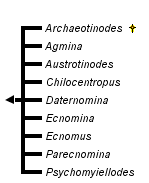Ecnomidae
Karl Kjer


This tree diagram shows the relationships between several groups of organisms.
The root of the current tree connects the organisms featured in this tree to their containing group and the rest of the Tree of Life. The basal branching point in the tree represents the ancestor of the other groups in the tree. This ancestor diversified over time into several descendent subgroups, which are represented as internal nodes and terminal taxa to the right.

You can click on the root to travel down the Tree of Life all the way to the root of all Life, and you can click on the names of descendent subgroups to travel up the Tree of Life all the way to individual species.
For more information on ToL tree formatting, please see Interpreting the Tree or Classification. To learn more about phylogenetic trees, please visit our Phylogenetic Biology pages.
close boxIntroduction
This is a small to moderately sized family established by Ulmer (1903) first as a subfamily of Hydropsychidae, later as a subfamily within Psychomyiidae, and then as a family (Lepneva 1970), with the majority of the known diversity found in a single genus, Ecnomus McLachlan. However, this has changed in recent years as many new species and even genera have been recognized, primarily from the Australasian region. Eight genera are recognized, of which Ecnomus is the largest, with more than 260 species widespread in the Palearctic, Oriental, Afrotropical, and Australasian regions. Austrotinodes Schmid is largely endemic to the Neotropics with about 40 species, a few extending into the extreme southwestern USA. A 2nd New World genus, Chilocentropus Navás from Chile, is a nomen dubium; its type, of unknown sex, is presumed lost. The Australasian fauna has several endemic genera, each with about 10-20 species: Agmina Ward and Schefter (New Caledonia), Daternomina Neboiss (Australia, mostly Tasmania), and Ecnomina Kimmins (Australia, New Zealand, and New Caledonia). Two genera, with about 15 species total, are endemic to Africa: Parecnomina Kimmins and Psychomyiellodes Mosely. (From Holzenthal et al. 2007a)
Characteristics
The larvae of Ecnomus are well known (Lepneva 1970, Scott 1968, Ulmer 1957) as are those of Austrotinodes (Bowles 1995, Wiggins 1996). They construct tubes of silk and fine sand grains that are attached to rocks, wood, or submerged vegetation, and occur in both running and standing water. (From Holzenthal et al. 2007a)Discussion of Phylogenetic Relationships
Li and Morse (1997) provided a phylogenetic analysis of the 5 genera then known in the family and of the Chinese species of Ecnomus. Holzenthal et al. (2007b) place the family within Psychomyiodea.References
Bowles, D.E. (1995) A new species of Austrotinodes (Trichoptera: Ecnomidae) from Texas. Journal of the New York Entomological Society, 103, 155–161.
Holzenthal R.W., Blahnik, R.J., Prather, A.L., and Kjer K.M. 2007a. Order Trichoptera Kirby 1813 (Insecta), Caddisflies. In: Zhang, Z.-Q., and Shear, W.A. (Eds). 2007 Linneaus Tercentenary: Progress in Invertebrate Taxonomy. Zootaxa. 58 pp. 1668:639-698
Holzenthal R.W., Blahnik, R.J., Kjer K.M and Prather, A.L. 2007b. An update on the phylogeny of Caddisflies (Trichoptera). Proceedings of the XIIth International Symposium on Trichoptera. Bueno-Soria, R. Barba-Alvearz and B. Armitage (Eds). pp. 143-153. The Caddis Press.
Lepneva, S.G. (1970) Fauna of the USSR, Trichoptera II(1). Larvae and pupae of the Annulipalpia. Zoological Institute of the Academy of Science of the USSR, New Series, 88, 1–638.
Li, Y.J. & Morse, J.C. (1997) Species of the genus Ecnomus (Trichoptera: Ecnomidae) from the People's Republic of China. Transactions of the American Entomological Society, 123, 85–134.
Scott, K.M.F. (1968) On some Trichoptera from Northern Zululand, South Africa. Proceedings of the Royal Entomological Society London (B), 37, 1–8.
Ulmer, G. (1903) Ueber die Metamorphose der Trichopteren. Abhandlungen des Naturwissenschaftlichen vereins in Hamburg, 18, 1–154.
Ulmer, G. (1957) Köcherfliegen (Trichopteren) von den Sunda-Inseln. Teil III. Larven und Puppen der Annulipalpia. Archiv für Hydrobiologie, Supplement, 23, 109–470.
Wiggins, G.B. (1996) Larvae of the North American Caddisfly Genera (Trichoptera). University of Toronto Press, Toronto, 457 pp.
About This Page
Karl Kjer

Rutgers University, New Brunswick, New Jersey, USA
Correspondence regarding this page should be directed to Karl Kjer at
Page copyright © 2010 Karl Kjer
 Page: Tree of Life
Ecnomidae.
Authored by
Karl Kjer.
The TEXT of this page is licensed under the
Creative Commons Attribution-NonCommercial License - Version 3.0. Note that images and other media
featured on this page are each governed by their own license, and they may or may not be available
for reuse. Click on an image or a media link to access the media data window, which provides the
relevant licensing information. For the general terms and conditions of ToL material reuse and
redistribution, please see the Tree of Life Copyright
Policies.
Page: Tree of Life
Ecnomidae.
Authored by
Karl Kjer.
The TEXT of this page is licensed under the
Creative Commons Attribution-NonCommercial License - Version 3.0. Note that images and other media
featured on this page are each governed by their own license, and they may or may not be available
for reuse. Click on an image or a media link to access the media data window, which provides the
relevant licensing information. For the general terms and conditions of ToL material reuse and
redistribution, please see the Tree of Life Copyright
Policies.
- First online 20 July 2010
- Content changed 20 July 2010
Citing this page:
Kjer, Karl. 2010. Ecnomidae. Version 20 July 2010 (under construction). http://tolweb.org/Ecnomidae/141238/2010.07.20 in The Tree of Life Web Project, http://tolweb.org/





 Go to quick links
Go to quick search
Go to navigation for this section of the ToL site
Go to detailed links for the ToL site
Go to quick links
Go to quick search
Go to navigation for this section of the ToL site
Go to detailed links for the ToL site